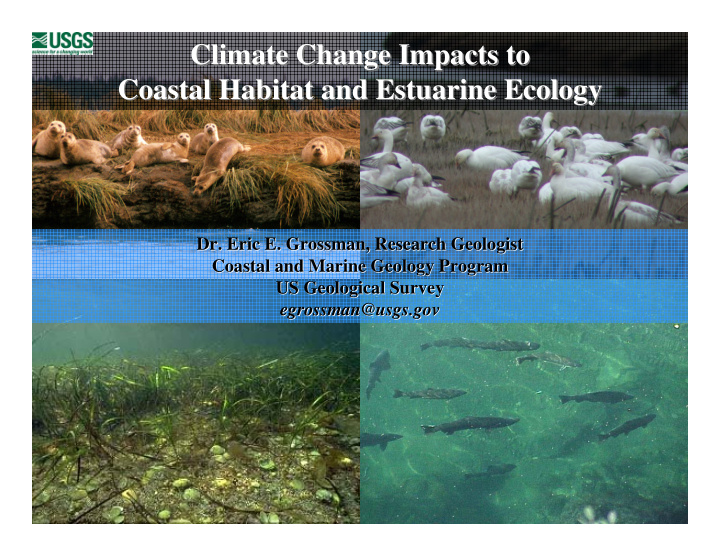



Climate Change Impacts to Climate Change Impacts to Coastal Habitat and Estuarine Ecology Coastal Habitat and Estuarine Ecology Dr. Eric E. Grossman, Research Geologist Dr. Eric E. Grossman, Research Geologist Coastal and Marine Geology Program Coastal and Marine Geology Program US Geological Survey US Geological Survey egrossman@usgs.gov egrossman@usgs.gov
Talk Outline Introduction Introduction - Importance of coastal ecosystems Importance of coastal ecosystems - - Problems and issues Problems and issues - Predicted climate- -driven changes driven changes Predicted climate Likely impacts: Likely impacts: - Habitats Habitats - - Processes Processes - - uncertainties/science needs uncertainties/science needs - Conclusions Conclusions Acknowledgements: Harriet Beale (Puget Sound Action Team), Margaret Dutch (WA ECY), Greg Hood and Eric Beamer (SRSC)
“Take home messages” 1) Climate change will impact coastal ecosystems 1) Climate change will impact coastal ecosystems that are already greatly modified by humans that are already greatly modified by humans 2) Ecological interactions are highly dynamic: 2) Ecological interactions are highly dynamic: vary spatially/temporally within coastal zone vary spatially/temporally within coastal zone 3) Wide range of adaptation outcomes; we need 3) Wide range of adaptation outcomes; we need greater knowledge and predictive capacity greater knowledge and predictive capacity
Interface between terrestrial, Interface between terrestrial, marine and atmospheric processes marine and atmospheric processes - High productivity, biodiversity High productivity, biodiversity - - Foundation of estuarine Foundation of estuarine foodweb foodweb - - Extensive area Extensive area -
Human modifications to habitat Human modifications to habitat and and hydrodynamic/geochemical processes hydrodynamic/geochemical processes - freshwater discharge and mixing freshwater discharge and mixing - Impoundment - sediment/contaminant/nutrient flux sediment/contaminant/nutrient flux - - distribution and timing of usable habitats distribution and timing of usable habitats - Land clearing Debris removal Diking and draining Diking/draining
Puget Sound Nearshore Nearshore Puget Sound Restoration Program Restoration Program PSNERP PSNERP Consortium of scientists, federal and Consortium of scientists, federal and local governments, NGOs, and local governments, NGOs, and resource managers tasked with resource managers tasked with developing scientific data and tools developing scientific data and tools to guide adaptive management of to guide adaptive management of nearshore habitats habitats nearshore Diking and draining
GPR Survey methods - mapping Coring Grainsize mapping Multibeam/seismic reflection/video Physical Oceanographic Instrumentation
Climate Forcing Climate Forcing Predicted Measured (1948 to 2003) � air temperature 1.5° F � water temperature ? � winter rainfall ? � flooding yes � snowpack yes Earlier snow melt (freshet) 12 days � summer river flow -18% � peak/daily river flow Increased � Annual river flow Decrease
Climate Forcing - - Process Responses Process Responses Climate Forcing
Climate Forcing - - Ecosystem Responses Ecosystem Responses Climate Forcing
Large-scale circulation in Puget Sound driven by marine and fresh-water mixing Salinity 2000 32 30 June 28 Dalco Admiralty Inlet Main Basin SJDF Passage Sills 32 30 December 28 Kawase 2002
Estuarine Food Web I mpacts may occur at any and all levels of foodweb and cascade through Just a few examples: Change in: - flow velocities - sediment type/input - nutrients - salinity - temperature Impacts: Substrate change - erosion/siltation Eutrophication Turbidity ( � light) Water quality Nutrient cycling
Marsh/Wetlands Productive avian/mammal habitat, migration corridors, nutrient/water cycling, agricultural centers
Marsh/Wetlands Productive avian/mammal habitat, Lower river flow migration corridors, nutrient/water Decrease sediment cycling, agricultural centers Higher salinity Increase floods Siltation Change in nutrient Coastal erosion Loss of marsh Peat decay Change in vegetation Eutrophication
Marsh/Tidal Channel Habitat Spawn/nursery habitat, migration corridor, Increase temperature, salinity nutrient/water pathway Decrease dissolved oxygen Lower flow velocities Siltation Increase/decrease nutrient? Decrease habitat, connectivity Physiologic “salinity” barriers Anoxia, stagnation Loss of substrate/benthic community Eutrophication, regime change
Skagit Delta Habitat Loss Skagit Delta Habitat loss ~1850 Today Collins (2000)
Eelgrass meadows Food, productivity, habitat structure, shelter/nursery, Increase temperature, salinity sediment stabilization Decrease dissolved oxygen Lower flow velocities, mixing Siltation, turbidity Increase/decrease nutrient Change in water quality and habitat; - tolerate range in Temp/Salinity - can eelgrass adapt? DNA studies Increase algal growth? Substrate/benthic community change Eutrophication?
Eelgrass Meadow “Die-Offs” Nelson Bay, SJI San Juan Islands 1983 (6.3 ha) 1995 (7.2 ha) Nelson Bay 1987 (6.5 ha) 2001 (2.2 ha) Wyllie-Echeverria et al. (2003)
Pocket Estuaries Nursery/forage habitat, Important along migration Increase temperature, salinity corridors Decrease dissolved oxygen Siltation, turbidity Increase/decrease nutrient Change in access to habitat Change in substrate Change in benthic community Eutrophication? 89% decrease in pocket estuary habitat in Skagit Bay alone (Beamer et al. 2003)
Migration Corridors <1850 Today Future? Sediment deposition flow dikes Fresh water Equitable flow Focused flow, Marine inundation and mixing salinity barriers higher delta salinities?
Conclusions 1) Climate change impacts will add complexity to 1) Climate change impacts will add complexity to ecosystems already affected by human activities ecosystems already affected by human activities 2) Dynamic ecological interactions require improved 2) Dynamic ecological interactions require improved understanding of spatial/temporal variability understanding of spatial/temporal variability 3) NEED: 3) NEED: - baseline and environmental variability data - baseline and environmental variability data - monitoring to evaluate change and test models - monitoring to evaluate change and test models - public interest and engagement in process - public interest and engagement in process
Recommend
More recommend